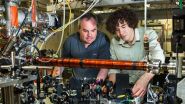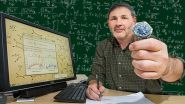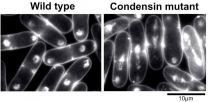(Press-News.org) CORAL GABLES, Fla. (May 27, 2015) - Autism Spectrum Disorder (ASD) is a neurological condition that affects approximately two percent of people around the world. Although several genes have been linked to multiple concurring conditions of ASD, the process that explains how specific genetic variants lead to behaviors characteristic of the disorder remains elusive.
Now, researchers are utilizing animal models to understand how dysfunction of either of two genes associated with ASD, SYNGAP1 and SHANK 3, contributes to risk in ASD. The new findings pinpoint the actual place and time where these genes exert influence in brain development and function. The findings are published in the journal Human Molecular Genetics.
"The overall goal of our study was to generate and directly compare two zebrafish models of ASD, to gain an in vivo perspective on how ASD genetic variants impact neural circuit development in embryos," said Julia E. Dallman, assistant professor of biology at the University of Miami (UM) College of Arts and Sciences and lead investigator of the study. "Our work begins to address a major gap in our current understanding of ASD."
The findings show that disrupting the expression or "knocking down" either SYNGAP1 or SHANK 3 genes affects early brain development in the mid and hindbrain regions and results in hyper-excitable behaviors.
"It is well known that genetics plays a significant role in ASD risk and that many genes are involved, but the exact nature of their involvement is not well understood," said Margaret A. Pericak-Vance, director of the John P. Hussman Institute for Human Genomics, the Dr. John T. Macdonald Foundation Professor of Human Genetics, at the UM Miller School of Medicine and co-author of the study. "The implications of the present study are important as it helps us understand how two ASD related genes, SHANK3 and SYNGAP1, contribute to the development of the disorder."
The study is titled "Two knockdown models of the autism genes SYNGAP1 and SHANK3 produce similar behavioral phonotypes associated with embryonic disruptions of brain morphogenesis." In contrast to previous studies of ASD-linked genes in humans and mice, the current study is conducted in developing zebrafish, because zebrafish embryos are transparent organisms that develop outside the mother, thus allowing the researchers to observe early brain development in the fish.
The researchers chose to analyze SYNGAP1 and SHANK3 orthologs--genes in different species that have a common ancestor and maintain the same function, since embryonic functions of these ASD-linked genes are unknown.
The study utilized three groups of fish. In two of the groups, the expression of either SYNGAP 1 or SHANK 3 genes was knocked down by injecting a molecule that specifically targets each gene. The third was also injected with a similar molecule, but with no match in the zebrafish genome, so it functioned as a control group. The behavior of larvae in all groups was analyzed by studying their escape responses in the presence of a stimulus.
The experiments showed that while control larvae swam away from the stimulus, the knock-down larvae had unproductive escape responses, as well as significantly reduced swimming velocities. Moreover, a subset of the knock-down larvae exhibited spontaneous seizure-like behaviors, and there were significant changes in the brain structure of these larvae, indicative of delayed development.
Together these findings support the emerging opinion that mutations of specific ASD-related genes disrupt early embryogenesis and that these early disruptions play a key role in the development of the disorder.
The team is now working to determine exactly how early developmental deficits impact later behaviors. In the long-term, they hope to use SYNGAP1 and SHANK3 zebrafish models for drug screening, to identify environmental risk factors and test potential therapies for ASD.
INFORMATION:
This work was generously supported by an NIH grant from the National Institutes of Mental Health to Julia Dallman and by funding from both the Seaver Foundation to Joseph Buxbaum and the John P. Hussman Foundation to Margaret Pericak-Vance.
Robert A. Kozol, graduate research assistant in the UM Department of Biology is first author of the study. Other coauthors from the UM Department of Biology are: James D. Baker, research assistant professor and Bing Zou, graduate student. From the UM John P. Hussman Institute for Human Genomics: Eden R. Martin, professor of human genetics and public health sciences; Michael L. Cuccaro, professor of human genetics and psychology; John R. Gilbert, professor of human genetics; Holly N. Cukier, assistant scientist; Vera Mayo, research associate; Anthony J. Griswold, associate scientist and Patrice L. Whitehead, research laboratory director. From The Seaver Autism Center for Research and Treatment Department of Psychiatry, Friedman Brain Institute and Mindich Child Health and Development Institute, Icahn School of Medicine at Mount Sinai: Silvia De Rubeis, postdoctoral fellow; Guiqing Cai, clinical molecular genetics fellow; and Joseph D. Buxbaum, professor of psychiatry, neuroscience, genetic and genomic sciences; and from the Department of Epidemiology and Biostatistics, Institute for Computational Biology, Case Western Reserve University School of Medicine: Jonathan L. Haines, professor, chair of the department of epidemiology.
http://www.as.miami.edu/news
The University of Miami's mission is to educate and nurture students, to create knowledge, and to provide service to our community and beyond. Committed to excellence and proud of our diversity of our University family, we strive to develop future leaders of our nation and the world.
Every year, an estimated half-million Americans undergo surgery to have a stent prop open a coronary artery narrowed by plaque. But sometimes the mesh tubes get clogged. Scientists report in the journal ACS Nano a new kind of multi-tasking stent that could minimize the risks associated with the procedure. It can sense blood flow and temperature, store and transmit the information for analysis and can be absorbed by the body after it finishes its job.
Doctors have been implanting stents to unblock coronary arteries for 30 years. During that time, the devices have evolved ...
One way to help the elderly cross what's known as the "digital divide" is the use of tablets, those smaller, lighter, easy-to-use computers that seem to be taking the place of laptops.
New Michigan State University research has found that the use of tablets does make it easier, breaking down some of the barriers that keep seniors from getting connected.
In addition to being smaller, lighter and more portable, tablets allow people to maneuver online without having to move and click a mouse.
"The dexterity required to control a mouse is really hard for some older adults," ...
An international team of astronomers, including researchers from the University of Cambridge, has identified a young planetary system which may aid in understanding how our own solar system formed and developed billions of years ago.
Using the Gemini Planet Imager (GPI) at the Gemini South telescope in Chile, the researchers identified a disc-shaped bright ring of dust around a star only slightly more massive than the sun, located 360 light years away in the Centaurus constellation. The disc is located between about 37 and 55 Astronomical Units (3.4 - 5.1 billion miles) ...
The DNA encoding all life on Earth is made of four building blocks called nucleotides, commonly known as "letters," that line up in pairs and twist into a double helix. Now, two groups of scientists are reporting for the first time that two new nucleotides can do the same thing -- raising the possibility that entirely new proteins could be created for medical uses. Their two studies appear in ACS' Journal of the American Chemical Society.
Synthetic biologists have been attempting for years to expand on nature's genetic "alphabet," consisting of the nucleotide bases cytosine, ...
With summer nearly here, U.S. consumers might think they have an abundance of sunscreen products to choose from. But across the Atlantic, Europeans will be slathering on formulations that manufacturers say provide better protection against the sun's damaging rays -- and skin cancer -- than what's available stateside, according to an article in Chemical & Engineering News (C&EN), the weekly newsmagazine of the American Chemical Society.
Marc S. Reisch, a senior correspondent at C&EN, reports that sunscreens on the U.S. market do protect users from some ultraviolet-A and ...
Patients treated for an acute respiratory infection by a doctor on a telephone or live video are as likely to be prescribed an antibiotic as patients who are treated by a physician face-to-face for the same illness, according to a new RAND Corporation study.
However, the patients treated virtually were more likely to be prescribed a broad-spectrum antibiotic -- concerning since overuse of the drugs increases costs and contributes to antibiotic resistance, according to the study.
Researchers say both treatment settings had high rates of inappropriate prescribing for ...
Some children with autism should undergo ongoing screenings for apraxia, a rare neurological speech disorder, because the two conditions often go hand-in-hand, according to Penn State College of Medicine researchers.
Over the course of a three-year study, 64 percent of children initially diagnosed with autism were found to also have apraxia. The study also showed that the commonly used Checklist for Autism Spectrum Disorder (CASD) accurately diagnoses autism in children with apraxia.
"Children with apraxia have difficulty coordinating the use of their tongue, lips, ...
The bizarre nature of reality as laid out by quantum theory has survived another test, with scientists performing a famous experiment and proving that reality does not exist until it is measured.
Physicists at The Australian National University (ANU) have conducted John Wheeler's delayed-choice thought experiment, which involves a moving object that is given the choice to act like a particle or a wave. Wheeler's experiment then asks - at which point does the object decide?
Common sense says the object is either wave-like or particle-like, independent of how we measure ...
An international team of scientists studying ultrafast physics have solved a mystery of quantum mechanics, and found that quantum tunneling is an instantaneous process.
The new theory could lead to faster and smaller electronic components, for which quantum tunneling is a significant factor. It will also lead to a better understanding of diverse areas such as electron microscopy, nuclear fusion and DNA mutations.
"Timescales this short have never been explored before. It's an entirely new world," said one of the international team, Professor Anatoli Kheifets, from The ...
This news release is available in Japanese.
Right before a cell starts to divide to give birth to a daughter cell, its biochemical machinery unwinds the chromosomes and copies the millions of protein sequences comprising the cell's DNA, which is packaged along the length of the each chromosomal strand. These copied sequences also need to be put back together before the two cells are pulled apart. Mistakes can lead to genetic defects or cancerous mutations in future cell generations.
Just like raising a building requires scaffolding be erected first, cells ...


